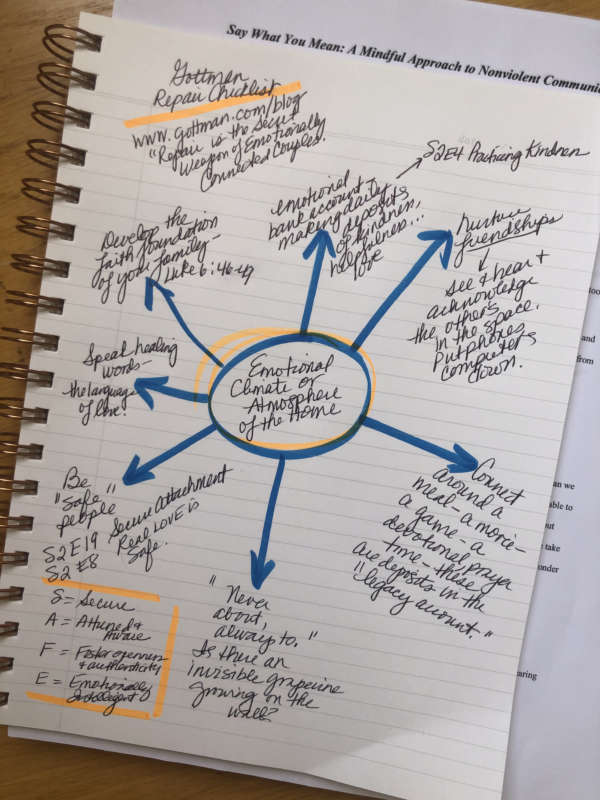Emotional repair is a necessary practice in all of our relationships, particularly and most importantly, within our family. In this episode of “Hallways of Home,” we talk about simple, practical ways to repair emotional wounds.
Emotional Repair

I am in what experts call, “the helping profession.”
I listen to the stories of men, women, and oftentimes, children/adolescents. And if I am listening, then more than likely, some part of their narrative is broken or skewed or needing some guidance.
I come to the table to help them find “emotional repair.”
In this episode, “Emotional Repair (Reparation),” I stand on the shoulders of Emotion Focused Family Therapy’s “Therapeutic Apologies,” and offer their “Five Steps to Facilitate a Successful Repair”:
- Acknowledge the unique impact of the emotional injury [wound] and how it may have contributed to a style of emotion avoidance. Emotion avoidance involves all the elaborate ways (coping, defense mechanisms, repression) we RUN AWAY or HIDE or NUMB or PUSH BACK from difficult emotional experiences. Psych Central offers five different ways we avoid: situation avoidance, cognitive avoidance, protective avoidance, somatic avoidance, and substitution avoidance. Bottom line? Avoiding tough emotions never ends well. Trust me. I was really good at avoidance. I know our fighting was really hard on you. I can see why you didn’t share with us how you were feeling at the time. It must have been really scary. I am so sorry I didn’t know how to handle myself better.
- Express appreciation for “what it must have been like,” for the event itself (the actual wounding incident) and the reluctance to share pain. In other words, “label and validate.” I can only imagine how hard it was for you to see us fighting. I bet you were angry, too, that we couldn’t find a better way to sort out our problems. I don’t blame you for feeling this way.
- Apologize and communicate authentic remorse. I am really sorry for how I acted. It pains me for how you have suffered.
- State what could have been done instead (even if nothing could have been done, say, ‘I should have found a way,’ and talk about what will change from that moment on. We should have found a way to protect you from our fights. We should have noticed how it was affecting you. We will change and do things different from this moment on.
- Wait for the blast/denial and proceed as follows. Emotion-Focused Family Therapy gives this scenario as to what might happen after steps 1-4: The “blast” or “blowup” or “flip the lid.” They write, “If a blast occurs after you apologize and your child repeats how they felt, and/or brings up OTHER injuries from the past, you might feel your apology was in vain. BUT, it actually is a good signal. A sign that your child actually FEELS HEARD and UNDERSTOOD, and they now trust you to continue to validate old feelings of hurt and pain. RESIST THE URGE TO FALL INTO THE TRAP OF BLASTING BACK. Instead, repeat STEPS 1-4 until the blast subsides. This response is KEY.
And, just in case you are struggling with the HOW’s and WHAT’s of creating a safe emotional atmosphere in your home/family, let’s lay that out, plain and clear.
How to Create a Safe Emotional Atmosphere/Climate in Your Home
“Every relationship has problems, because every person has problems, and the place that our problems appear most glaringly is in our close relationships. The key is whether or not we can hear from others where we are wrong, and accept their feedback without getting defensive. Time and again, the Bible says that someone who listens to feedback from others is wise, but someone who does not is a fool.”
― Henry Cloud, Safe People: How to Find Relationships That Are Good for You and Avoid Those That Aren’t
A Quick Overview of SEVEN Key Ingredients in a Healthy Emotional Atmosphere
After several clients challenged me with this question, “I just don’t get this ‘safe parent’ thing. I provide a house, education, clothes…heck, everything my kid needs. What isn’t safe about that?”
I thought, “I need to simplify and show what being ‘a safe parent’ and providing ‘a safe home,” really looks like. On paper. So, I created this simple little sketch to help clarify and differentiate between being “safe emotionally,” and being “safe physically.”

For the sake of our conversation here, we are only talking about being “safe emotionally,” in our relationships. Domestic violence and child abuse are NOT on the table in this conversation. We are solely speaking of EMOTIONAL safety.
I jotted down SEVEN ingredients to get started:
- A nurturing environment in which every single member, from the smallest to the oldest, feel SEEN, HEARD, and KNOWN. When someone walks in the room, do you acknowledge their presence? Put the phone down, look up from your tablet or computer, and actually GREET them as if they are present. We’re talking PRESENCE here (see HEALTHY FAMILIES).
- Make daily deposits into the FAMILY EMOTION BANK ACCOUNT: practice kindness, live a life of love, be selfless and do things before being asked, practice hospitality and consideration, etc.
- Connect around the family table for at least ONE MEAL a day or heck, even one meal a week. Watch a movie. Play a game. Come together for family prayer or a short devotional or just talk. How was your day? Your week? What were the highs and lows? How can we best support each other right now, especially during these times of pandemic and unrest? These ACTIONS are deposits in your LEGACY bank account.
- Establish this rule of healthy communication: “Never about, Always to.” Is there an invisible grapevine that exists between family and even extended family members? Use discretion and wisdom on when to share and when to hold family issues close to your own heart. Do unhealthy boundaries erode trust?
- Be a SAFE person and parent: Secure; Attuned and Aware; Foster Openness and Authenticity; and Embrace Emotional Intelligence.
- Speak HEALING words, not HARMFUL or HURTFUL words. Yes, you will have disagreements and conflict, but do they have to always involve yelling or raging or defensiveness?
- Last but NOT the least, develop your FAITH foundation. Read Luke 6:46-49. Are building a legacy founded on ROCK qualities or SAND qualities?
This is a lot of information, I know, but you’ve asked for show notes to use alongside the podcast, so here you go.
I pray they are helpful and useful tools to make you and your family stronger every single day.
More Remarkable Resources
- Take the LOVE QUIZ.
- Visit https://www.boundaries.me/ and join this online resource center for $9/month. WORTH every single penny. This will save you $$ and time and energy in therapy sessions.
- Visit https://www.emotionfocusedfamilytherapy.org/ for more insight on emotional intelligence.
- Join my online FB private community: Stronger Every Day
